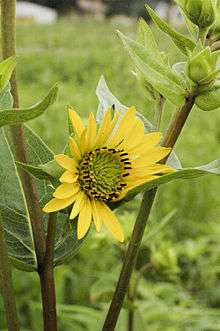Silphium integrifolium
| Silphium integrifolium | |
|---|---|
 | |
| Scientific classification | |
| Kingdom: | Plantae |
| (unranked): | Angiosperms |
| (unranked): | Eudicots |
| (unranked): | Asterids |
| Order: | Asterales |
| Family: | Asteraceae |
| Tribe: | Heliantheae |
| Genus: | Silphium |
| Species: | S. integrifolium |
| Binomial name | |
| Silphium integrifolium Michx. | |
Silphium integrifolium is a species of flowering plant in the aster family, Asteraceae. Its common names include whole-leaf rosinweed, entire-leaf rosinweed, and prairie rosinweed.[1] It is native to eastern North America, including Ontario in Canada and the eastern and central United States as far west as New Mexico.[2][3]
Description
This species is a perennial herb growing from a fibrous root system and producing stems up to 2 meters tall.[4] It can form a large clump of up to 100 stems.[5] The stems are hairless to slightly rough-haired, and sometimes waxy in texture. The leaves are oppositely arranged on the stems. The basal leaves are lost by maturity. The leaf blades are lance-shaped to ovate, smooth-edged or toothed, hairless to rough-haired, and up to about 23 centimeters long.[4] The inflorescence holds one to 15 flower heads.[5] The head is lined with 2 or 3 rows of phyllaries which are hairless or rough and sometimes glandular. The head has up to 36 yellow ray florets and many yellow disc florets. The fruit has a short pappus.[4]
There are two varieties of the species:[4]
- S. integifolium var. integrifolium – 40 centimeters to 2 meters in height
- S. integifolium var. laeve – generally 1 to 1.5 meters tall, with more florets and hairless leaves
Ecology
The foliage of the plant is eaten by herbivores such as the white-tailed deer and the blister beetle Epicauta fabricius. Plants have also been noted to lose approximately 17% of their fruits to lepidopteran larvae. The most common herbivorous insect on this species is the gall wasp Antistrophus silphii. The wasp injects its eggs into the apical meristem of the plant, and as its larvae develop, a spherical gall up to 4 centimeters wide forms in the meristem. This stops the shoot from growing. Up to 30 larvae overwinter in each gall, pupate, and emerge as adult wasps the following season.[5]
Uses
The plant had uses among Native American peoples. The Meskwaki, for example, used the roots to treat pain from injuries.[6]
This species is cultivated for use in gardens.[7]
References
- ↑ Silphium integrifolium. NatureServe. 2012.
- ↑ "Silphium integrifolium". Germplasm Resources Information Network (GRIN).
- ↑ "Silphium integrifolium". County-level distribution map from the North American Plant Atlas (NAPA). Biota of North America Program (BONAP). 2013.
- 1 2 3 4 "Silphium integrifolium". Flora of North America (FNA). Missouri Botanical Garden – via eFloras.org.
- 1 2 3 Fay, P. and D. C. Hartnett. (1991). Constraints on growth and allocation patterns of Silphium integrifolium (Asteraceae) caused by a cynipid gall wasp. Oecologia 88(2), 243-50.
- ↑ Silphium integrifolium. Native American Ethnobotany. University of Michigan, Dearborn.
- ↑ Silphium integrifolium. Missouri Botanical Garden.
External links
-
 Media related to Silphium integrifolium (category) at Wikimedia Commons
Media related to Silphium integrifolium (category) at Wikimedia Commons -
 Data related to Silphium integrifolium at Wikispecies
Data related to Silphium integrifolium at Wikispecies - "Silphium integrifolium". Natural Resources Conservation Service PLANTS Database. USDA.
